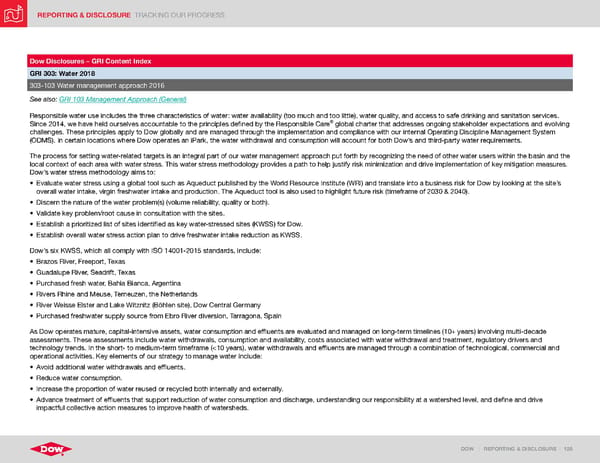REPORTING & DISCLOSURE TRACKING OUR PROGRESS DOW | REPORTING & DISCLOSURE | 128 Dow Disclosures – GRI Content Index GRI 303: Water 2018 303-103 Water management approach 2016 See also: GRI 103 Management Approach (General) Responsible water use includes the three characteristics of water: water availability (too much and too little), water quality, and access to safe drinking and sanitation services. Since 2014, we have held ourselves accountable to the principles defined by the Responsible Care ® global charter that addresses ongoing stakeholder expectations and evolving challenges. These principles apply to Dow globally and are managed through the implementation and compliance with our internal Operating Discipline Management System (ODMS). In certain locations where Dow operates an iPark, the water withdrawal and consumption will account for both Dow’s and third-party water requirements. The process for setting water-related targets is an integral part of our water management approach put forth by recognizing the need of other water users within the basin and the local context of each area with water stress. This water stress methodology provides a path to help justify risk minimization and drive implementation of key mitigation measures. Dow’s water stress methodology aims to: • Evaluate water stress using a global tool such as Aqueduct published by the World Resource Institute (WRI) and translate into a business risk for Dow by looking at the site’s overall water intake, virgin freshwater intake and production. The Aqueduct tool is also used to highlight future risk (timeframe of 2030 & 2040). • Discern the nature of the water problem(s) (volume reliability, quality or both). • Validate key problem/root cause in consultation with the sites. • Establish a prioritized list of sites identified as key water-stressed sites (KWSS) for Dow. • Establish overall water stress action plan to drive freshwater intake reduction as KWSS. Dow’s six KWSS, which all comply with ISO 14001-2015 standards, include: • Brazos River, Freeport, Texas • Guadalupe River, Seadrift, Texas • Purchased fresh water, Bahia Bianca, Argentina • Rivers Rhine and Meuse, Terneuzen, the Netherlands • River Weisse Elster and Lake Witznitz (Böhlen site), Dow Central Germany • Purchased freshwater supply source from Ebro River diversion, Tarragona, Spain As Dow operates mature, capital-intensive assets, water consumption and effluents are evaluated and managed on long-term timelines (10+ years) involving multi-decade assessments. These assessments include water withdrawals, consumption and availability, costs associated with water withdrawal and treatment, regulatory drivers and technology trends. In the short- to medium-term timeframe (<10 years), water withdrawals and effluents are managed through a combination of technological, commercial and operational activities. Key elements of our strategy to manage water include: • Avoid additional water withdrawals and effluents. • Reduce water consumption. • Increase the proportion of water reused or recycled both internally and externally. • Advance treatment of effluents that support reduction of water consumption and discharge, understanding our responsibility at a watershed level, and define and drive impactful collective action measures to improve health of watersheds.
 ESG Report | Dow Page 127 Page 129
ESG Report | Dow Page 127 Page 129